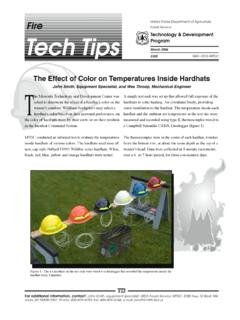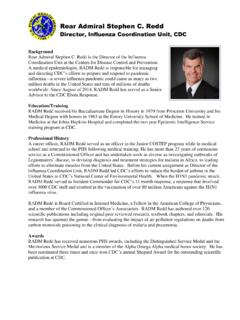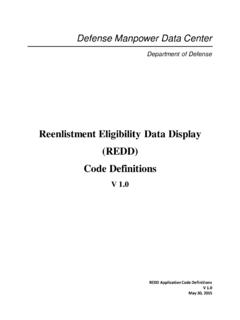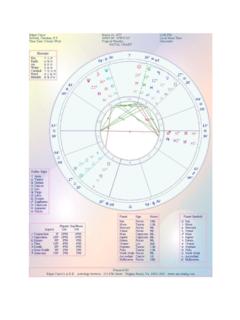Transcription of Discrimination of Chinook Salmon, Coho Salmon, …
1 284 North American Journal of Fisheries Management25:284 300, 2005[Article]qCopyright by the American Fisheries Society 2005 DOI: of Chinook Salmon, Coho Salmon, and SteelheadRedds and Evaluation of the Use of redd Data for EstimatingEscapement in Several Unregulated Streams inNorthern CaliforniaSEANP. GALLAGHER*California State Department of Fish and Game,1031 South Main Street, Suite A, Fort Bragg, California 95437, USACOLINM. GALLAGHER1 Department of Mathematics and Statistics,Holt Hall, California State University Chico, Chico, California 95929, USAA bstract.
2 We developed and evaluated a stratified index redd area method to estimate ChinooksalmonOncorhynchus tshawytscha, coho salmonO. kisutch, and steelheadO. mykissescapementin several coastal streams in northern California based on the assumption that redd size is relatedto the number of redds a female builds. Sources of error in redd counts were identified, includingthe use of logistic regression to classify redd species (necessary due to temporal overlap in thespawning of these species in coastal northern California). redd area escapement estimates werecompared with estimates from more conventional methods and releases above a counting efficiency in redd detection ranged from ( ) to ( ) and wassignificantly associated with streamflow and water visibility (analysis of variance [ANOVA] ;P, ).
3 Logistic regression reduced uncertainty in redd identification. redd area anddate observed were significant in predicting coho salmon and steelhead redd species (Wald and , respectively;P, ). Pot substrate and redd area were significant in classifyingChinook and coho salmon redds (Wald and ; and , respectively).Stratified index redd area escapement estimates and estimates based on capture recapture exper-iments, area-under-the-curve estimates, and known releases above the counting structure (cohosalmon only) were not significantly different (ANOVA:F, ; ).
4 Escapement estimatesassuming one redd per female were only significantly different from other methods for steelhead( ; ). redd counts were significantly correlated with escapementestimates ( ;P, ). Reduction of counting errors and uncertainty in redd identification,biweekly surveys throughout the spawning period, and the use of redd areas in a stratified indexsampling design produced precise, reliable, and cost-effective escapement estimates for Chinooksalmon, coho salmon, and estimates of escapement are essentialfor effective management and conservation of sal-monids (Busby et al.)
5 1996; McElhany et al. 2000).In northern California coastal Chinook salmonOn-corhynchus tshawytscha, coho salmonO. kisutch,and steelheadO. mykissare listed as threatenedspecies under the Endangered Species Act( Office of the Federal Register 1997, 1999,2000). Estimates of abundance at the populationlevel are likely to be an important, though notindependent, part of delisting criteria. There is a* Corresponding author: address: Department of Mathematical Sciences,Clemson University, Clemson, South Carolina 29634-0975, February 4, 2004; accepted June 8, 2004 Published online March 4, 2005need for reliable, cost-effective, and precise tech-niques for monitoring salmonid redd counts are commonly used to indexadult escapement and assess population trends(Beland 1996; Rieman and Myers 1997; Isaak etal.
6 2003), their accuracy as a measure of abun-dance has rarely been evaluated (Dunham et ). As the product only of reproductive adults, redd counts provide an index of effective popu-lation size (Meffe 1986). Maxell (1999) suggeststhat the sources of counting errors involved in reddcounts be identified and reduced before they willbe useful for long-term monitoring. Dunham et al.(2001) suggest that redd counts are less intrusiveand expensive than tagging, trapping, underwaterobservation, weirs, and genetics for inventoryingbull troutSalvelinus confluentuspopulations, andthat with limited resources more populations can285 ESTIMATING SALMON AND STEELHEAD redd ESCAPEMENTbe inventoried over a longer period.
7 However, theyconclude that substantial improvements are neededto reduce counting errors before redd counts willbe useful for population monitoring. The use ofredd counts for population monitoring may be fur-ther complicated if females make more than oneredd. Crisp and Carling (1989) found that femalesalmonids occasionally make more than one redd ,and Reingold (1965) documents a steelhead mak-ing two redds in different locations within astream. Salmonids may also make false or test redds, which are abandoned before eggs are de-posited (Crisp and Carling 1989).
8 The use of redd counts for population monitor-ing may be further complicated if there is uncer-tainty in redd species identification. Identificationof Chinook and coho salmon and steelhead reddsin coastal northern California streams is difficultbecause of overlap in spawning time and redd siz-es. Chinook and coho spawn from late Octoberthrough January, and steelhead spawn from De-cember through March in coastal northern Cali-fornia (Weitkamp et al. 1995; Busby et al. 1996;Myers et al. 1998). redd surface areas range to 15 m2for Chinook salmon, from m2for coho salmon (Burner 1951), and to m2for steelhead (Orcutt et al.)
9 1968).Thus, to use redd counts for population monitoringin coastal northern California it was necessary todevelop a technique to distinguish redd resolve some of the weaknesses listed above,we evaluated the amount of bias in estimates dueto errors in redd species identification, detectionof redds, and duration under variable survey con-ditions. We used data collected over 2 years infour rivers and three creeks to develop a logisticregression model based on physical redd charac-teristics and spawning time to distinguish betweencoho salmon and steelhead redds and tested it withdata collected in the third year of the study.
10 Todistinguish between Chinook and coho salmonredds, a similar model was developed and evalu-ated with data collected in two rivers during 1 evaluated the validity and some sources of biasinvolved with using redd counts and redd sizes toestimate escapement by estimating surveyor effi-ciency, the duration redds remain visible, and theinfluence of streamflow and water visibility onredd detection. To determine if redd -based esti-mates differed from conventional escapement ap-proaches, we examined the relationship betweenthese estimates and estimates based on capture recaptureexperiments,area-under-the-curv e(AUC) estimates, and counts at the Noyo RiverEgg Collecting Station (ECS) between 2000 and2001 and between 2002 and 2003.



















